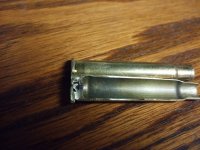I've read on other forums about people using a rubber o-ring in front of the rim to keep the case from getting pushed forward by the firing pin. Theory is that it keeps the case held back so all the stretching is done at the front of the case and these rings do not develop. Anyone ever try this? Did it work? I'm not overly familiar with the enfields so I couldn't answer specifically if the bolt face is the numbered/interchangeable type.
Reloaders are infatuated with the firing pin and then they are impressionable, I say think about it and still after all these years the same question is asked over and over with the same answers; and then? There is the poison tree; don't listen to him


.
The 303 British Enfiled has rear locking lugs, I know, that is confusing but when the lugs are at the rear of the bolt the part of the bolt between the lugs and chamber bends/humps. Even if head space is reduced and the case off sets case travel the bolt still humps/bends; that is the way it is.
And then there is part of the case that off sets the length of the chamber; the rim. No one measures, even if they did measure the thickness of the rim and found it to be thin there is nothing that can be done about it because case manufacturers do not sell cases to reloaders that know what they are doing.
The nicest thing to ever happen to the 303 British case is P.O. Ackley, Ackely took the taper out of the case and increased the angle of the shoulder; meaning the case could be reduced by sizing the case to the shoulder of the chamber instead of the rim.
And then I always say there is something about the sequence of events that happen between pulling the trigger and the bullet leaving the barrel reloaders do not understand. And reloaders are gullible, they believe it is so cool to repeat the story about the firing pin. The story goes something like the firing pin strikes the primer and then the whole shebang (case, powder. bullet and primer) take off for the front of the chamber. And I always say I have killer firing pins; my firing pins crush the primer before the case, powder and bullet know their little buddy, the primer, has been crushed. And then most get confused and blame me; that is OK because.
My primers when struck can launch the case forward. Normal about right here is suggest reloaders think about it, it is a volunteer thing. Remember, if the reloader chooses not to think about it gets complicated; With the case shoulder against the shoulder of the chamber the rim failed to hold the case back. In the sequence of things the case body expands and locks onto the chamber.
REMBER: The primer drove the case forward, and the case head is no longer against the bolt face. When this happens and pressure builds, the case body locks onto the chamber and the case head is driven back against the bolt face. Meaning? The only way all of this stuff can is for the case to stretch between the case head and case body. Ine more time, I am the fan of cutting down on case travel.
And I always ask how much clearance is there between the front of the rim or how much clearance is there between the back of the rim and bolt face when the case is driven forward.
In the big inning cases had shoulders with long tappers, that goes for the case bodies, most cases had long tappers. Again, P.O. Ackely was the best thing to happen to cases with long tappers on the case body and shoulders, these cases included the 300 H&H. Instead of a rim the H&H has a belt.
and then there are reloaders that believe the shoulder moves, as always I say think about it but all I can do is make most mad and or confuse them. If my shoulder moves when I pull the trigger the case stretches between the case head and case body and friends and reloaders that is the beginning of case head separation.
So? What is it I want to avoid? I want to prevent the firing pin from driving my case shoulder forward; I know, it is a cute saying but I have killer firing pins and I want to cut down on case travel.
F. Guffey


